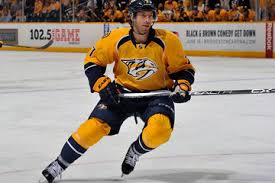 The Penguins signing of soon to be 39 year old Matt Cullen last week has been met with lots of praise. He remains an okay player at his age, due to his speed and hockey sense, there was zero risk from the Penguins end, and if you wanted to acquire a role player like Cullen at the trade deadline, they usually go for a mid-round pick, have been among the arguments for signing Cullen from pundits and of course many of the fan blogs who believe the Penguins walk on water.
The Penguins signing of soon to be 39 year old Matt Cullen last week has been met with lots of praise. He remains an okay player at his age, due to his speed and hockey sense, there was zero risk from the Penguins end, and if you wanted to acquire a role player like Cullen at the trade deadline, they usually go for a mid-round pick, have been among the arguments for signing Cullen from pundits and of course many of the fan blogs who believe the Penguins walk on water. However, dig a little deeper makes you ponder whether the signing was necessary.
Evaluators often say you want youth at forward not on blueline if you believe you’re a Stanley Cup Contender like the Penguins brass fully believes.
The Penguins will be opposite this season with youth on defense with Derrick Pouliot and Brian Dumoulin expected to play bigger roles on the blueline and limited spots available at forward.
In the NHL the belief is often that players begin to trend down at 28 years old. A growing trend around the league is having youth at forward with 25 years old or younger often being the bench mark.
The Tampa Bay Lightning who the Penguins want to be, have nine forwards among their projected top-13 who are currently 25 years old or younger. Many of them big time contributors and they’re not the only team in the East with that type of trend.
The Penguins currently project to have two regulars in their lineup next season who are 25 years old or young, Sergei Plotnikov and Beau Bennett.
With Eric Fehr sidelined to start the year, maybe Scott Wilson becomes the third player under 25 to be in the lineup.
The New York Rangers who by overall calculations are a slightly older team than the Penguins, but among their significant contributors or players expected to play big roles this season, many are 25 years old or younger.
Derek Stepan, Kevin Hayes, Chris Kreider, Jesper Fast, Emerson Etem among that group at forward.
That critical area will be missing again this season from the Penguins.
One concern with the Penguins from those who scout for a living have expressed is going to be the Penguins defensive play in the d-zone from the forwards.
Cullen known as a soft player also doesn’t come with recommendations as a strong defensive player.
Eric Fehr and Matt Cullen are winger capable which isn’t a bad but both are stronger players at center and Fehr has made it clear he doesn’t want to be a winger anymore.
“I want to be a centerman,” Fehr told the Washington Post in May. “I think it helps my game. I think I enjoy playing defensively and trying to be quick on pucks and help the breakout. I can’t really picture myself being a full-time winger anymore.”
In speaking with Fehr’s agent Craig Oster, Fehr signed in Pittsburgh with the belief of being the Penguins third line shutdown center and Nick Bonino is not too open I’m told of moving to winger, despite some scouts believing he could transition to the wing well.
The argument of why wait until the season when it would cost a draft pick to acquire a Matt Cullen when you can sign him for nothing now may have strong support but a mistake General Manager’s often make is trying to make their team in the summer instead of having an open mind of letting things play out.
At the end of the day, the better option for the Penguins was either keeping another spot open for a young player or bringing in a depth scoring winger.
With Kevin Porter or Oskar Sundqvist to fill the void for Fehr, the Penguins didn’t need another center.


